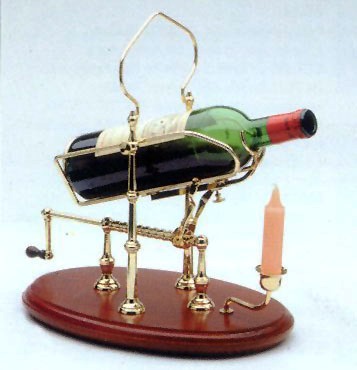
< Previous / Next >
 |
Article Index < Previous / Next > |

Dinner at the Ritz
- a tale of questionable taste
Across an otherwise empty room, I curiously watch as a
dinner party of eight well-dressed guests orchestrate a flurry of
circulating wait staff. Dinner at the famous Hôtel Ritz was a priority
for Jacquie and I while in
Our
intent was to stay the night, in one of the hotel’s famous rooms that lie
just beyond the Hall of Temptation. This seemingly endless corridor is
home to numerous objects of desire including rare jewels, designer garments,
and assorted artifacts. Each item is locked just out of reach, within
the flanking rows of glass display cases. Those with bottomless pockets or
a gross lack of self-control are more than welcome to purchase these
treasures. For Jac and me, the sight was enough to fuel our sense of
imagination for many years to come.
My profession had me displaced in
The events of this evening occurred at a point when my
knowledge of wine was only beginning to blossom. I knew enough to
recognize the intricate actions and proceedings of the sommelier, but in
truth, I failed to understand the significance of the wine. I have also
replayed this evening in my mind a thousand times, to the point where the
memory is greatly obscured. The reason for the constant need to recall
this event is purely out of fascination and perhaps an element of hindsight.
Let me explain…
From our table we could easily enjoy the uninterrupted ambience of this legendary establishment and yet remain close enough to keep tabs on the high-price patrons across the room. After a round of cocktails, our first course arrived. Judging by the presentation and taste, nothing at the Ritz is second best. Even the linen serviettes were embroidered and pressed to perfection - I nabbed one as a souvenir.
The sommelier resurfaced with what appeared to be a very
old and dust covered bottle from the cellar. He presented the label to
the host of the party across the room and then carefully placed the bottle
in its basket back on to his guerdon. We watched in awe as the
contents trickled from the bottle into a flask by way of an old hand-crank
decanting cradle, a procedure that to this day I have only witnessed on this
occasion. The sommelier sampled the wine and then continued to pour a
taste for the host’s approval. This was obviously a very special
bottle and certainly a rare occasion for his fortunate group. I sat in
envy.
To the shock of the entire table and a slightly defensive
stance from the highly trained wine steward, the gentleman hosting the
dinner party turned the bottle away.
Declining a bottle of wine is a perfectly acceptable
practice. Unfortunately though, most people do it for the wrong
reasons. If the bottle is not what you asked for or it is flawed, i.e.
it tastes like vinegar or smells of sulphur or wet cardboard, you should
return it. In fact, most knowledgeable staff at better restaurants
won’t even present the sample taste if they suspect that the bottle’s
contents are in question. Understand as well, that if the wine does
not suit your ‘personal taste’, it is very poor etiquette to send it back.
Over time, the pronounced fruit character of win e
begins to fade, giving way to more earth driven sensations such as leather,
cedar, and spice box to name a few. In terms of colour, white wine
takes on a deeper hue while all reds become less vibrantly so.
Needless to say, when the host of the party in question turned this
particular bottle away, the conversation at the waiters’ station and within
earshot of our table became unquestionably direct.
e
begins to fade, giving way to more earth driven sensations such as leather,
cedar, and spice box to name a few. In terms of colour, white wine
takes on a deeper hue while all reds become less vibrantly so.
Needless to say, when the host of the party in question turned this
particular bottle away, the conversation at the waiters’ station and within
earshot of our table became unquestionably direct.
My limited knowledge of the French language at the time
posed no barrier to the situation; the tone of their voices told the entire
story. The wine was Chateau Petrus; the vintage, I will never know, but when
our waiter stopped by to replenish our water glasses, I inquired about the
obvious concern across the room. Was the wine flawed? I asked. His
response while cautious was also quite honest: ‘No monsieur, the wine is
perfect; the bottle is just very old.’ ‘An expensive loss, I’m sure.’
I commented. ‘Yes,’ he replied, ‘it sells for over 5000 euros (francs
at the time) and is the last example of that label in our cellar.’
The staff quickly cleared the still full decanter and
empty bottle from the table and curiously left it with a gentleman sitting
just out of our view – the owner perhaps? Mr. Al-Fayed… he was with another
person, with whom he shared the deeply scarred wine.
The loss of revenue in a situation like this does not
bother me; hotels of this calibre make money hand-over-fist. Rather, I am
dismayed by the obvious arrogance and wasted opportunity for this group to
taste what others might only dream of enjoying.
We finished our meals and wandered through the hotel
before strolling under the streetlights along rue Saint-Honoré, stopping of
course to see the famous chocolate waterfall. Many years have past
since this memorable evening and yet on occasion, I am still able to recall
the sequence of events.
 The
facts have become rather twisted over time and as I relive the story late at
night, my mind slipping further into the subconscious, the
tale evolves with an alternate ending. You see, I have tasted this
wine on countless occasions. Our waiter that evening was perceptive
enough to sense our keen interest and enthusiasm and kindly offered us each
a single glass of the great Château Petrus…1945. On each occasion, the
vintage elixir has exceeded all of my expectations and to this day remains
the greatest wine ever to stain my imagination.
The
facts have become rather twisted over time and as I relive the story late at
night, my mind slipping further into the subconscious, the
tale evolves with an alternate ending. You see, I have tasted this
wine on countless occasions. Our waiter that evening was perceptive
enough to sense our keen interest and enthusiasm and kindly offered us each
a single glass of the great Château Petrus…1945. On each occasion, the
vintage elixir has exceeded all of my expectations and to this day remains
the greatest wine ever to stain my imagination.
Reasons to reject a bottle of wine
- As written by T.Philp and published in the autumn 2012 edition of Footprints magazine
| return to the Article Index | ||
Tyler Philp is a member of the Wine Writers' Circle of Canada Please direct inquires for writing services to: info@tylerphilp.com |
||
| Copyright © 2013 Tyler Philp
prior permission required for duplication of material |
||